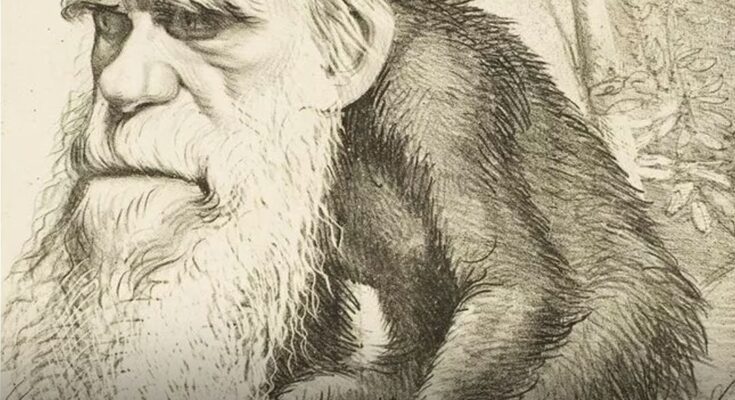Technological and scientific advances rose rapidly during the late 19th and early 20th century, prompting a worldwide interest in all the new – and sometimes very strange – possibilities science had to offer. Humanzees, man-ape hybrid soldiers, presented one such possibility.
This was the age of steel, the railroad, the factory system, and even eugenics. But before Europe fully moved towards extreme nationalism and surprising figures campaigned for breeding a master race, a lone Russian scientist who had successfully crossbred a variety of mammals – including zebras and donkeys – got the idea to try and breed humans with apes. But his name was not Josef Stalin; it was Ilya Ivanov, and he was exploring the human-ape hybrid possibility long before Stalin ever succeeded in politics.
Over the years, and thanks to articles published by creationist organizations, Ivanov’s weird experiments were conflated with Stalin, who supposedly asked scientists to breed a race of man-ape hybrid soldiers who would be super strong and serve in an enormous Soviet army. Such plans were never on Stalin’s radar; indeed, such a fighting force was never even of interest to Ivanov. All he wanted to do was prove the creation of a humanzee was possible.
The real story of how Ivanov managed to secure a small amount of funding from the Soviet government to conduct artificial insemination experiments on both humans and chimpanzees is far more intriguing than the rumors – but just as despicable.
-
Stalin Is Easy To Pin The Blame On, But He Wasn’t Responsible
Photo: Unknown / Wikimedia Commons / Public Domain
Josef Stalin is an easy mark upon which to place blame for a multitude of evils because – in many cases – he actually was guilty. But the suggestion that he encouraged, funded, or otherwise directed a project to create a hybrid race of human-ape people who would serve as super warriors in the Soviet Army is not only patently absurd, but also false.
Certainly, the scientific advances of the 19th and early 20th century proved fertile ground for even the wildest, most unethical experiments and programs. One only has to consider the corruption of eugenics to understand that the scientifically learned and the politically and financially powerful people of the world were keen to use “science” to further subjugate and control populations. The creation of ape-men, however, wasn’t even on the Soviet radar. It was 20th century creationists who began promoting the false story as a means of strengthening their arguments against evolution.
-
A Wrongly Cited Academic Journal Brought Stalin’s Name Into The Fold
Creationist publications based their claims of Stalin’s culpability on a single journal article written by Russian scientist, Kirill Rossiianov. Since academic journals are typically peer-reviewed, the source seemed legitimate, until one read the original article and realized Rossiianov was writing about the earlier Russian scientist, Ilya Ivanov, who had indeed conducted – or attempted to conduct – some experiments on artificially inseminating female chimpanzees with human sperm, as well as inseminating human women with chimpanzee sperm.
Stalin’s name, influence, or approval are nowhere to be found in the Ivanov case or the Rossiianov article. It is quite likely that Stalin either knew nothing about it or read about it in the newspapers, just like everyone else.
-
If It Wasn’t Stalin, Who Led The Man-Ape Hybrid Crusade?
Photo: Головачев, Пётр Михайлович / Wikimedia Commons / Public Domain
Ilya Ivanov was a highly respected scientist with a keen dedication to the wild and wonderful new world of scientific possibilities brought on at the turn of the 20th century. Despite – or perhaps because of – his passion, Ivanov didn’t necessarily ask if something should be done, even if it was technically possible. So, he had a bit of a problem with ethics.
Most of his career was spent working with livestock to improve horse breeding, however, and he became known across the world for his studies and successes with artificial insemination. Indeed, he was able to produce hybrids in livestock, including a zebra/donkey mix known as the “zeedonk.”
Moreover, anyone who thinks Soviet leadership convinced Ivanov to explore the possibilities of human-ape hybrids needs to look further back in Ivanov’s past, since he was talking, writing, and lecturing about a possible human-ape crossbreed as early as 1910.
-
Ivanov Received Funding For His Experiments Following The Bolshevik Revolution
During the years following the 1917 Bolshevik Revolution, Ivanov thought the time might be right to approach the new regime for funding. This was not to develop super-warriors, however, but to conduct general artificial insemination procedures similar to those he had already done; though, of course, this time it would be far more controversial since humans were involved. But he didn’t gain much support, and none of it came from Stalin.
In 1924, the Soviet government, specifically the Soviet Financial Commission, along with approval from the Soviet Academy of Sciences, awarded Ivanov the equivalent of $10,000 to explore the human-ape hybrid possibilities. So prestigious was the event, famed scientist Ivan Pavlov was present for the occasion.
-
Ilya Ivanov First Inseminated Female Chimps With Human Sperm
Photo: Alain Houle / Wikimedia Commons / CC BY 4.0
Armed with his newfound grant money, Ivanov and his team arrived at a research station in French Guinea in March 1926. At the research station, local hunters would poach chimpanzees in the wild and bring them back to scientists in order for them to perform their experiments.
Eventually, Ivanov wound up with three juvenile female chimpanzees, which were soon inseminated with human sperm. But the insemination did not take.
-
He Tried To Inseminate Women From French New Guinea Without Their Consent
After the insemination of chimpanzees failed, Ivanov decided to inseminate unknowing African women with chimpanzee sperm. He planned to do so under the pretense of a standard medical exam. Luckily, his plan was rejected by the governor of French Guinea.
Ivanov was forced to return to Russia, where he soon enacted another plan for experimenting on humans.
-
Back In Russia, Five Women Volunteered For Insemination With Chimpanzee Sperm
Photo: Unknown / Wikimedia Commons / Public Domain
Back home in Russia, Ivanov went about implementing his newest scheme for creating a human-ape hybrid. He had 20 chimpanzees sent over from Africa, with the idea being to form a Soviet chimp nursery. All but four of the animals died before arriving in Russia, though.
Ivanov brought the remaining four to a warmer region of the USSR. He then managed to convince five local women to agree to artificial insemination with chimpanzee sperm. He was again unable to carry out the experiment, however, as the final four chimpanzees died shortly after arriving.
-
Debunking Religion, In Part, Motivated Ivanov’s Work
Photo: Unknown/The Hornet Magazine / Wikimedia Commons / Public Domain
Part of the Soviet embrace of Ivanov’s experiments had to do with their relationship to Darwin’s Theory of Evolution. Ivanov’s thinking was premised on Darwin’s work; he believed that breeding humans with apes would further evidence their close relationship on the evolutionary tree. This, in turn, would further demonstrate the superiority of science over religion – a major part of the Soviet project to discredit and disavow religion altogether.
Given Ivanov’s (at least partial) motivation in this regard, it’s little wonder that his failure to produce a humanzee added fuel to the creationist Christian fire.
-
Ivanov’s Failed Experiments Inspired Creationists To Spread The Word That Darwin’s Theories Were False
Photo: Unknown / Wikimedia Commons / Public Domain
Creationist supporters and evangelical Christians, even in the earlier part of the 20th century, saw great value in promoting the failure of Ivanov’s experiments. After all, if humans and chimps – closely related, according to Darwinism – could not breed, then Darwin’s theory, in their minds, were proven invalid.
This was the moment that sparked the widespread promotion of the Stalin/Soviet man-ape super-warrior story, because it allowed opponents of Darwinism to discredit the scientist and his theory in the same breath as the reviled Stalin.
-
Ideas Of Human-Ape Breeding Eventually Fell Out Of Favor
Photo: Rudolf Cronau / Wikimedia Commons / Public Domain
By the time Ilya Ivanov’s government funding was exhausted, the scientific world had also tired of the human-ape breeding idea. The continuing growth of nationalism across Europe led leaders and citizens to explore a different approach to eugenics.
While the original concept involved parents being able to optimize the genes of their children – potentially eliminating disease or picking things like eye color – nationalists like the Nazi party saw eugenics as a way of eliminating “lesser” populations and encouraging the “finest” human specimens to breed more of themselves. In short, the idea of an Aryan “master race” quickly replaced the concept of ape-human warriors. Before long, the very concept of eugenics became scientifically and socially unacceptable.
-
The Soviets Embarked On A Purge Of ‘Inferior’ Humans – And Ivanov Was Among Them
Many political movements wind up consuming their own. Look at what happened to Robespierre after the French Revolution, for example. Scientist Ilya Ivanov did not come to the brutally violent end met by the French leader. But when Stalin decided to conduct a purge of the Soviet scientific community in 1930 – one of many purges of intellectuals during his reign in 1930 – Ivanov was arrested, accused of inciting a counterrevolutionary movement, and exiled to Kazakhstan, where he died two years later
-
This Wasn’t The End Of The Humanzees Idea
Photo: Internet Archive Book Images / Wikimedia Commons / No known copyright restrictions
It turns out Ivanov’s ideas didn’t exactly die with him. In the unusual case of Oliver the chimpanzee, a strangely human-esque chimp, claims were made that the primate existed somewhere in the genetic space between humans and chimps. Besides his striking appearance, reports indicated he had 47 chromosomes, as opposed to the normal 48 for chimps, seemingly placing him closer to the 46 found in humans.
Oliver’s DNA was tested in 1996, however, and the claims were disproved. The tests indicated he did, in fact, possess the 48 chromosomes of a chimp. Still, Oliver’s unusual appearance is still something of a curiosity.











